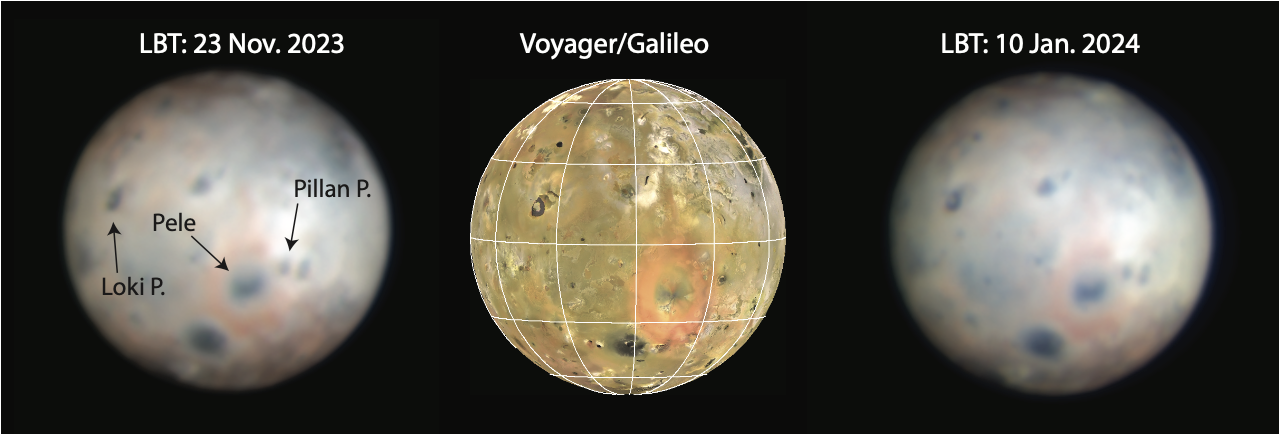Pele meets Pillan: Demonstration of a new method for monitoring surface changes on Io
- 1LBTO, Tucson, United States of America (aconrad@lbto.org)
- 2INAF Osservatorio Astronomico di Roma,Italy
- 3University of California, Berkeley, USA
- 4Jet Propulsion Laboratory - California Institute of Technology, Pasadena, USA
- 5California Institute of Technology, Pasadena, USA
- 6Steward Observatory, The University of Arizona, Tucson, USA
A new development in the field of adaptive optics (AO) on ground-based telescopes enables routine monitoring of changes on Io's surface at scales down to ~80km (achieved), or even down to ~50km (in the limit). Our observations, taken with SHARK-VIS on the Large Binocular Telescope (LBT) in Arizona, demonstrate this new capability. SHARK-VIS adds a visible light science channel to the AO system at LBT. While AO science in the infrared has been widespread for decades, visible-light AO science is new. SHARK-VIS, which saw first light at LBT on October 2nd, 2023, is one of only a few visible-light AO instruments on large telescopes.
Our images of Io, taken soon after first light, are of the highest spatial resolution ever attained from a ground-based telescope. In addition to confirming known surface features, these images show a previously unseen plume deposit that obscures a portion of Pele's persistent red ring (see Fig. 1). This plume deposit, we believe, came as the result of a powerful eruption at Pillan Patera.

Figure 1. The SHARK-VIS detection image on Nov. 23, 2023 (upper left), and again on Jan. 10, 2024 (upper right), and the reprojection of the Voyager and Galileo spacecraft-derived Io photomomosaic for Jan. 10, 2024 (center) (Becker & Geissler, 2005).
To determine the date of the Pillan eruption, we analyzed thermal emission data collected by other telescopes over the last four years. Although these infrared images were necessarily taken at lower spatial resolution (due to the wavelengths used), the spatial resolution is sufficient to detect if and when excess thermal emission might have originated from Pillan Patera. These data show a spike in thermal emission, indicating a powerful eruption, during August 2021. Augmented with data from the Juno JIRAM instrument, we believe that this spike corresponds to the eruption responsible for the plume deposit seen in the SHARK-VIS images.
These SHARK-VIS images serve as a demonstration of how adaptive optics at visible wavelengths will allow us to monitor surface changes on Io at regular intervals. Note that, prior to the SHARK-VIS observation, the most recent high-resolution imaging of the Pele region was from the New Horizons fly-by during March 2007. By April 2024, as seen by the visible imager on the Juno spacecraft, the red ring around Pele had repaired itself. Without the SHARK-VIS images, this resurfacing event would have never been detected.
To date, regular monitoring of Io using ground-based facilities has largely been restricted to M-band (4.8 μm) imaging which, even using adaptive optics on 8-10 metre telescopes, yields spatial resolution of about 400-600 km. While there will always be a need for infrared images of Io for the thermal data that informs volcanology, visible-light images at 50-80km resolution allow us to "see" the landscape, to more accurately locate the effects of eruptions and associated features such as plume deposits.
In our presentation, we will provide details of the Pillan plume deposit and its encroachment onto Pele's ring, and how that observation serves as a demonstration of how we will be able to monitor surface changes on Io going forward. We will also describe future ground-based systems that could produce imaging of Io down to spatial scales below 12km.
How to cite: Conrad, A., Pedichini, F., Li Causi, G., Antoniucci, S., de Pater, I., Davies, A. G., de Kleer, K., Piazzesi, R., Testa, V., Vaccari, P., Vicinanza, M., Power, J., Ertel, S., Shields, J. C., Ragland, S., and Giorgi, F.: Pele meets Pillan: Demonstration of a new method for monitoring surface changes on Io, Europlanet Science Congress 2024, Berlin, Germany, 8–13 Sep 2024, EPSC2024-147, https://doi.org/10.5194/epsc2024-147, 2024.